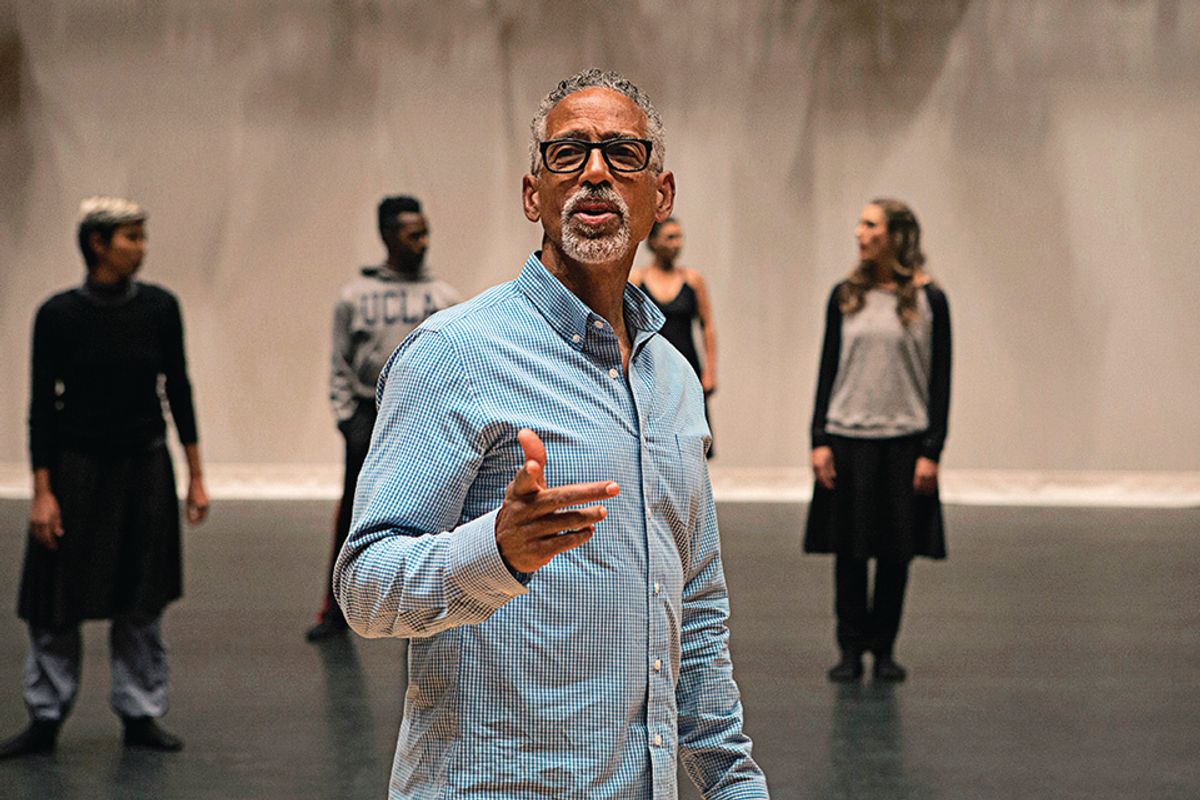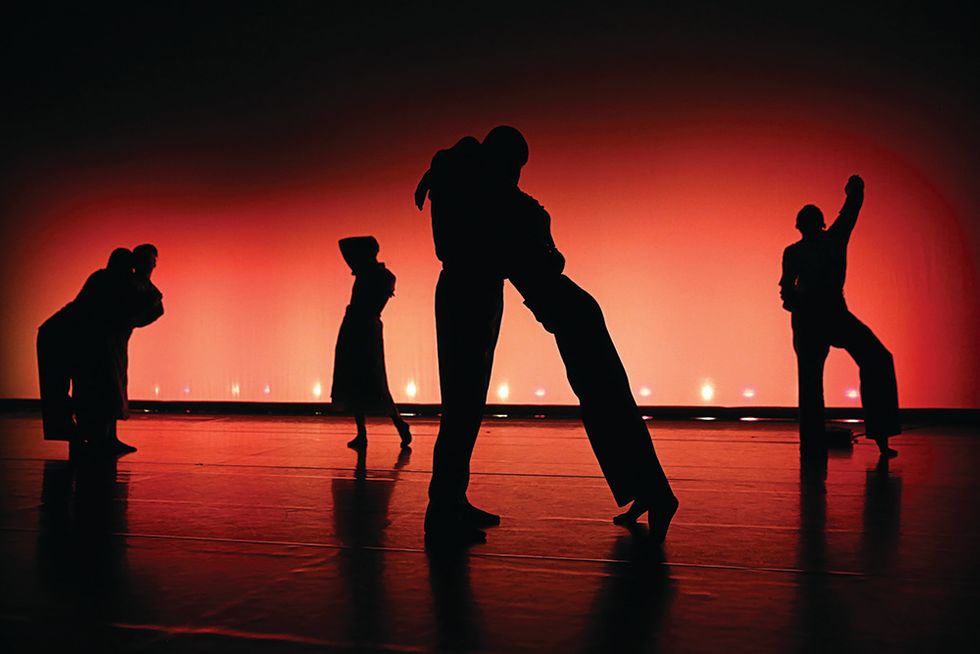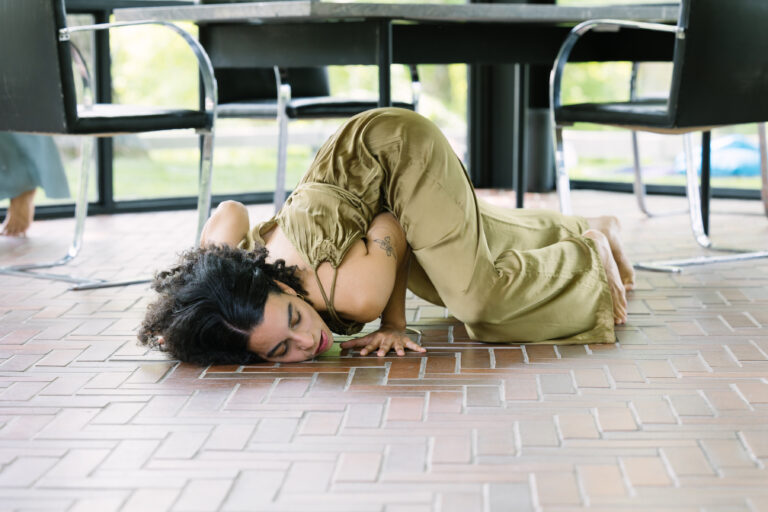
David Roussève has spent the last 35 years creating dance theater work that’s both fiercely political and personal. He took on AIDS with The Whispers of Angels (1995), same-sex marriage with Jumping the Broom (2005) and the Twitter generation with Stardust (2014). Dance writer Deborah Jowitt characterizes his work as treading “a fine line…between gritty tragedy and fairytale pathos.” For every critic who might accuse him of occasionally tugging too hard on his audience’s heartstrings, there’s someone else who thinks his work “offers a succinct and lyrical look at how the highs and lows of life collide” (Sarah Kaufman, for the Washington Post). But perhaps, more than anything, Roussève is interested in the process of discovery. He wants every choreographic experience to feel different.
Lately, his process has been tied directly to his students at the University of California, Los Angeles. After a fulfilling career making movement alone in the studio to set on his company and others, Roussève, now 60, has discovered the strengths—and challenges—of working collaboratively with his dancers, many of whom he first encounters in the classroom.
“I had to decide what my ‘rules’ of choreography were.”
After studying at Princeton and spending several years dancing with Toronto Dance Theatre and other companies, the Houston native settled in New York City in 1981 and began to create his own work. “I became not disillusioned but unfulfilled by dancing—I started to think that it wasn’t as exciting to interpret other people’s thoughts and concepts,” says Roussève. “No one was saying and exploring the things I wanted to. So I thought I should try to say them myself.”
He followed the lead of his predecessors who had experimented at the Judson Dance Theater and adopted a self-taught approach to choreography. His influences were far-ranging—from Broadway musicals to Pina Bausch to alternative, downtown dance. “In the downtown dance community, at least, there was a sense of ‘anything goes,'” he says. “You had the right to have your own idiosyncratic voice.” Much of his early attempts, he admits, were extended periods of trial and error. “I just kept making pieces over and over,” he says. “No one was teaching me about time and space and negative space and unison versus non-unison—all the ‘rules’ of choreography. I had to decide what my ‘rules’ of choreography were. I had to figure out, ‘What does it mean to have someone center stage? What about downstage right?'”
“It’s learning by doing—we investigate together.”
When Roussève joined the faculty of UCLA in 1996, the dance department was in transition—and so was he. “I was ready for a shift in my company’s nonstop touring,” he says. UCLA invited him to join their mission to rethink what a university dance department could be. Ironically, he soon found his niche in teaching dance composition. “Undergrads arrive without their own artistic voices, so I teach them concepts like space and time and vocabulary,” he says. “Instead of teaching rules, though, I’m teaching how an understanding of space, say, might affect meaning in dance. It’s learning by doing—we investigate together.”
An investigative approach also works with the graduate population. UCLA, he explains, attracts candidates who represent a diverse selection of genres. Roussève might have a grad student who specializes in hip hop alongside someone with a postmodern background next to someone with bharatanatyam training. “There’s nothing unifying all of these forms,” he says, “except trying to somehow facilitate a way for the artist to strengthen their own idiosyncratic choreographic language.” His way in has been by asking questions, like: What are the rules and requirements of these forms of dance? How do they define virtuosity? How do their forms define what it means to strengthen yourself? “I’d have to enter into these forms,” he says, “and that’s what kept things exciting and fresh for me.”
The evolution of students themselves over the course of his 24-year career at UCLA has also been enlightening. Though he notes that the attention span of today’s students might be a bit shorter than in years past, they’re more interested in what he calls “an experience of depth.”
“For the first 15 years at UCLA, there was a constant struggle around commercial dance versus modern dance,” he says. “Now, students are really starting to see that good dancing is just good dancing. There’s no schism between wanting to become a studio baby and do commercial dance versus, say, doing modern conceptual performance art. They’re starting to accept the rigor of more contemporary forms of composition.”
“What academia has given me is a little bit of breathing room.”
Like many artists who become educators, Roussève has found a real symbiosis between his choreography and his teaching career. “I noticed early on that my work was getting stronger from my teaching,” he says. One major change has been the way he enters his creative process. Up until 10 years ago, he tended to create the spoken text before he started creating the movement. “Then there was a switch, and now movement is the priority and depth of the work,” he says. What accounted for the change? “I recognized that the movement wasn’t as strong as the text,” he says, “so I thought, ‘What if I really make the priority about investigating a movement language, over the spoken language?'”
Most importantly, academia has afforded him the luxury of time. “Before, I was constantly churning out new pieces, whether those were commissions for other companies or work for my own company,” he says. “That’s your livelihood, constantly looking for new work and making new work. What academia has given me is a little bit of breathing room. The combination of having the time for an actual long-term development process has really strengthened my work.”
When beginning a new work, Roussève will often workshop material with his UCLA students to get an idea of what shape it might take with his company, David Roussève/REALITY. “It’s great research-gathering time,” he says. “I’ll have some vague ideas and general thoughts, and then I’ll run classes like a professional rehearsal process. We’re getting some thoughts about what the kinetic vocabulary of the piece might look like—it’s a great way to work out initial ideas. I want the students to learn about choreography by creating with me in a professional-level development process.”
It’s also a way for him to recruit company members. For his most recent piece, Halfway to Dawn, seven of the nine performers were from UCLA, both former undergrad and grad students. “I’d rather try out someone who I’ve worked with as a student—where I have a sense of what they may be like, or what they can do—than have an open audition,” he says.
One thing hasn’t changed over more than three decades. Roussève is still committed to reinventing himself. He lets each work take him someplace new. “That’s how I keep from becoming jaded—by entering the studio and really trying to push yourself into the unknown,” he says. “I hope I’m always lost when I start a new piece.”





